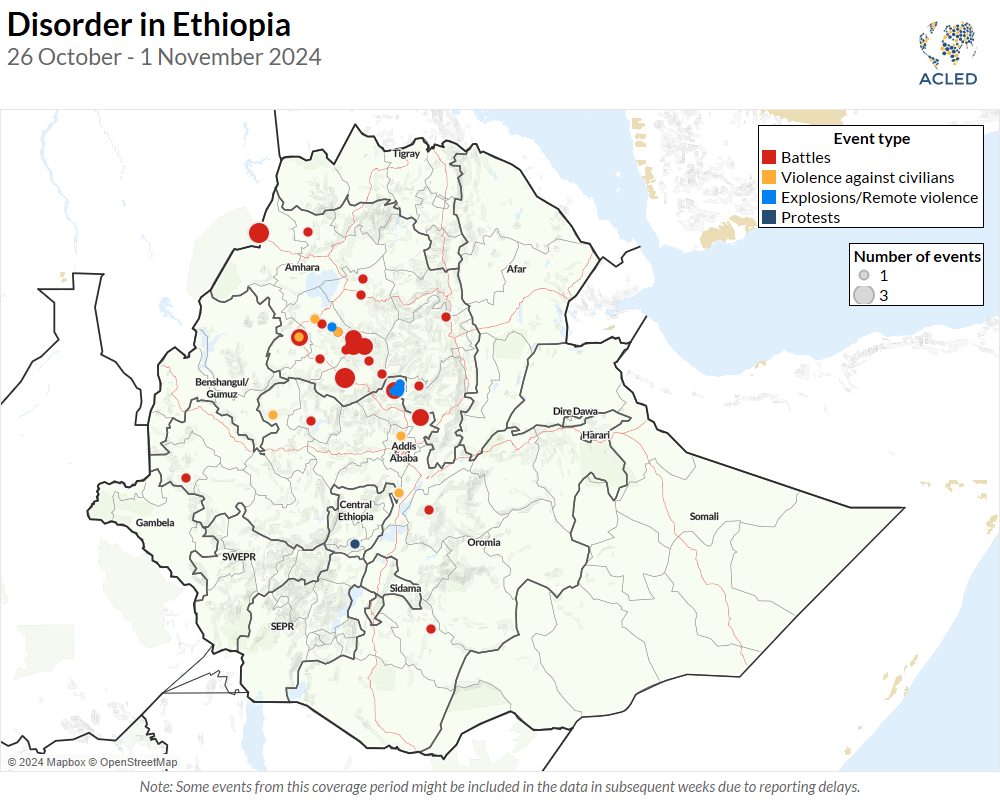Situation summary
Last week in Oromia region, several high-fatality battle events and attacks against civilians involving the Oromo Liberation Army (OLA) — referred to by the government as the Oromo Liberation Front (OLF)-Shane — were reported, contributing to a recent rise in events involving the group. Meanwhile, battles between Fano militias and the Ethiopian National Defense Force (ENDF) in Amhara region affected urban areas of Motta and Addis Kidame towns.
Fatalities among civilians and security forces rise in Oromia region
On 30 October, OLA/OLF-Shane militants reportedly killed at least 38 civilians in Dereba, Kure, and Bitisi areas in Birbirsa Gali kebele, located 18 kilometers east of the city of Meki in East Shewa zone. According to witnesses, perpetrators conducted house-to-house searches, shooting civilians and burning houses after accusing the victims of supporting the government.1Seyum Getu, Eshete Bekele, and Yohanes Gebre-Egziabher, ‘Eyewitnesses said that many people were killed in two zones of Oromia region’, DW Amharic, 1 November 2024 This attack prompted the ENDF and other regional forces to deploy to this area2Yonatan Zebdios and Gelmo Dawit, ‘Residents said that at least 38 civilians were killed in an attack by militants in the Oromia region,’ VOA Amharic, 2 November 2024 and is the most deadly attack against civilians in Oromia region since November 2022. As with many of the previous high-fatality civilian targeting incidents involving the OLA/OLF-Shane, the victims of this attack were predominantly ethnic Amhara and Gurage.3Yonatan Zebdaws, Gelmo Dawit, ‘Residents said that at least 38 civilians were killed in an attack by militants in the Oromia region,’ VOA Amharic, 2 November 2024 The official spokesperson for the OLA/OLF-Shane said he was unaware of the attack and insisted that the group was not responsible.4Yonatan Zebdaws, Gelmo Dawit, ‘Residents said that at least 38 civilians were killed in an attack by militants in the Oromia region,’ VOA Amharic, 2 November 2024
Fighting between the government and OLA/OLF-Shane forces continued during the week, with clashes reported in Arsi, Guji, Horo Guduru Wollega, Kellem Wollega, and North Shewa zones, with residents of Guji, North Shewa, and Kellem Wollega zones reporting widespread network cuts as a government response to renewed fighting.5Gelmo Dawit, ‘Residents in Ethiopia’s Oromia region report network disruptions as government forces fight rebels,’ Voice of America, 31 October 2024 On 1 November, the OLA/OLF-Shane ambushed Oromia state police and kebele militias in Wuchale woreda, North Shewa zone, killing at least 45 government security forces and local administrators, including the head of Wuchale woreda. An OLA/OLF-Shane spokesperson confirmed that the group was responsible for the attack and claimed it had killed as many as 67 soldiers, in addition to “several” administrators.6Twitter @OLF_OLA, 1 November 2024 An unidentified number of people, including the head of the woreda’s kebele militia office, were also injured. Administrative officials are routinely the target of violent attacks in Oromia region, and since 1 November 2023, ACLED records at least 11 such incidents carried out by the OLA/OLF-Shane, unidentified armed groups, or Fano militias.
There were several signs leading to growing optimism for another round of peace talks between the OLA/OLF-Shane and the government. However, the targeted killing of the woreda head and security forces in North Shewa zone marked a key point in the trajectory of the Oromia conflict. Since April 2024, political violence events involving the OLA/OLF-Shane have been on the decline, though in July and October 2024, events slightly increased. Jal Sanyi Nagasa, former commander of the OLA/OLF-Shane central zone, which recently separated itself from the main OLA/OLF-Shane leadership, indicated his willingness to engage in peace talks with the government. Meanwhile, the Oromia Regional President Shimelis Abdisa’s 10 October announcement indicating potential for peace talks between the regional government and the OLA/OLF-Shane central command also led to hope that the conflict in Oromia could reduce further. However, clashes and the killings of higher-level officials and government forces in North Shewa — in the OLA/OLF-Shane’s central zone — reduce the likelihood that peace talks will occur in the near future.
Battles in Amhara region reignite in urban areas
In Amhara region, battles between Fano militias and the ENDF renewed in urban locations, with fresh clashes in Motta town in East Gojam zone and Addis Kidame town in Awi zone resulting in closed businesses and interrupted transportation.7Aster Misganaw, ‘Residents said that some shops were closed due to the continued shooting in the Amhara region,’ Voice of America, 28 October 2024 Previously, fighting was reported around Motta town from 5 to 8 October, and in Addis Kidame on 3 October. In addition to Motta and Addis Kidame, clashes were reported in Awi, Central Gondar, East Gojam, North Shewa, South Gondar, South Wello, West Gojam, and West Gondar zones during the last week.
Fighting in Amhara region has moved into more populated locations throughout the latter half of 2024, affecting the lives of millions of people. Last week, Prime Minister Abiy Ahmed announced that the government was holding conversations with armed groups in both Amhara and Oromia regions, also stressing that anti-peace forces in Amhara region had hindered government-initiated development projects.8BBC Amharic, ‘The question of Ethiopia’s sea gate is reasonable and fair – Prime Minister Abiy Ahmed,’ 31 October 2024

Ethiopia at a Glance
26 October – 1 November 2024
The data cover the period from 26 October to 1 November 2024. For more information about how ACLED collects data and categorizes events, see the ACLED Codebook. Some events from this coverage period might be included in the data in subsequent weeks due to reporting delays.
Political Violence Events9This includes the Battles, Explosions/Remote violence, and Violence against civilians event types, as well as the Mob violence sub-event type of the Riots event type.: 47
+62% from previous week
Demonstration Events10This includes the Protests event type as well as the Violent demonstrations sub-event type of the Riots event type.: 1
0% from previous week
Event Types
Battles: 33 Events
Explosions/Remote Violence: 6 Event
Violence Against Civilians: 7 Events
Mob Violence: 0 Events
Protests: 1 Event
Violent Demonstrations: 0 Events





